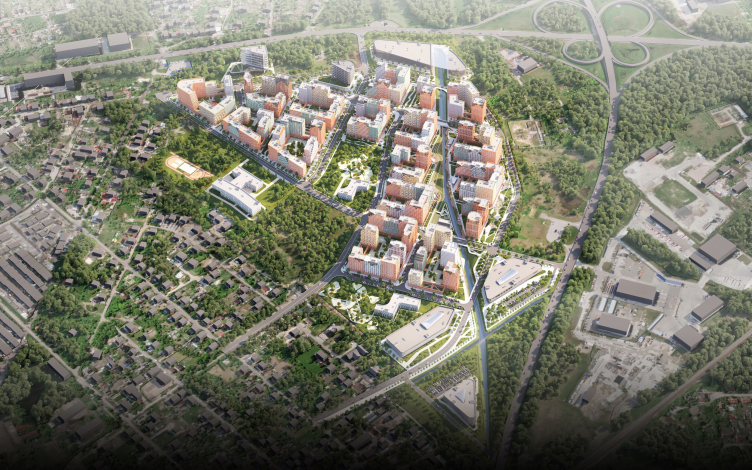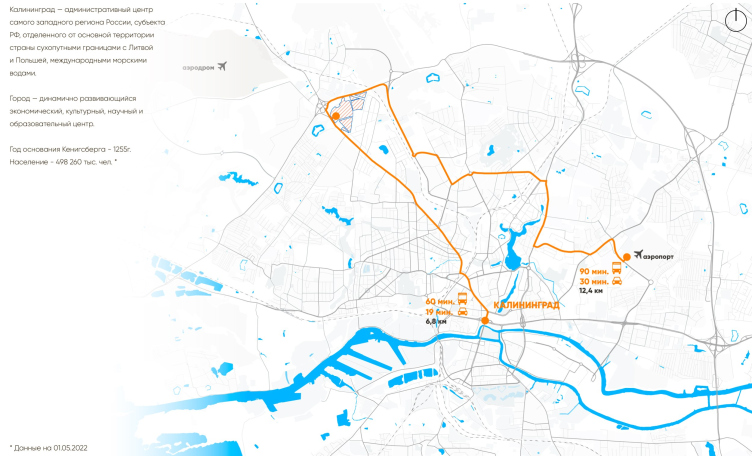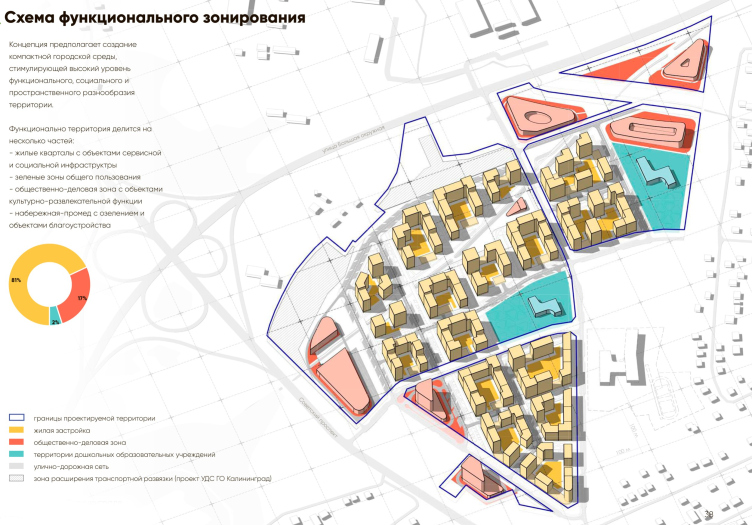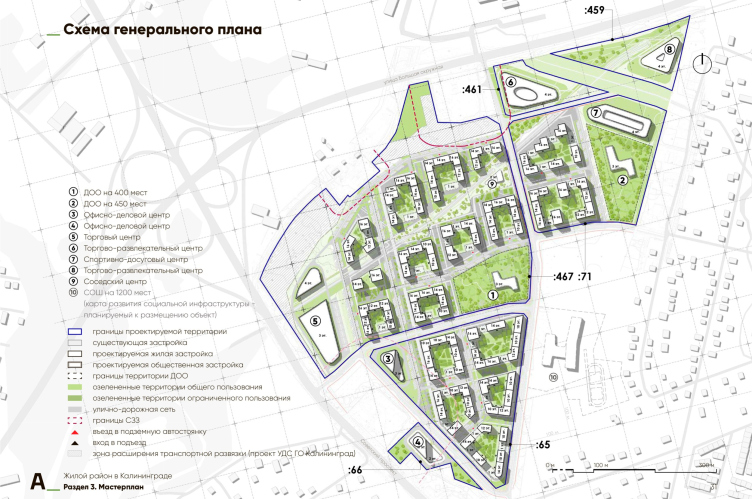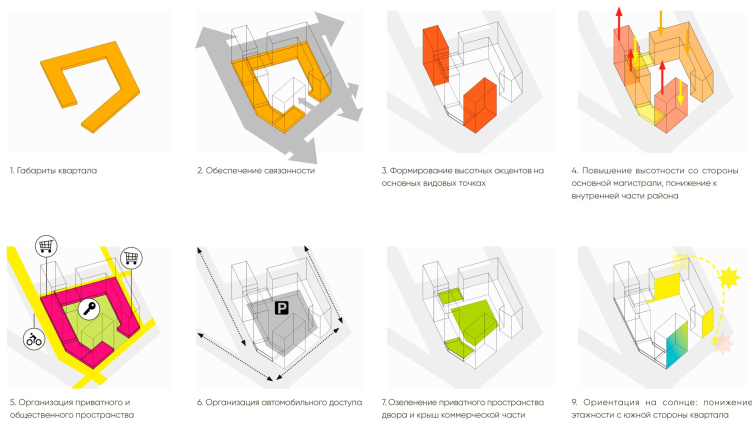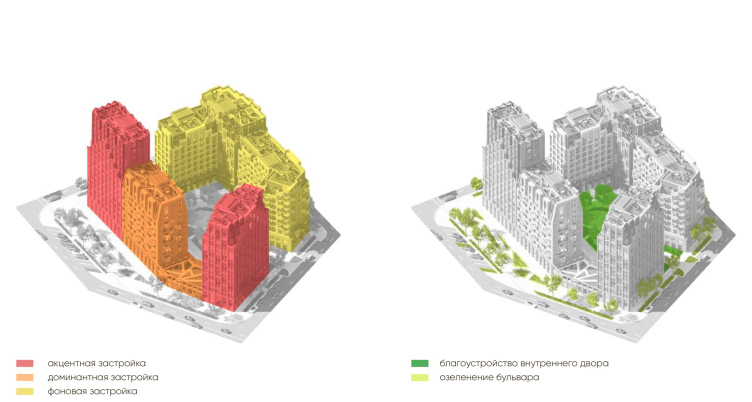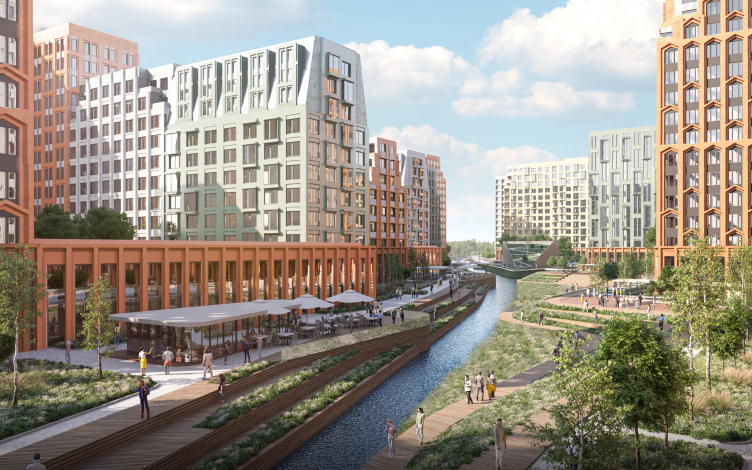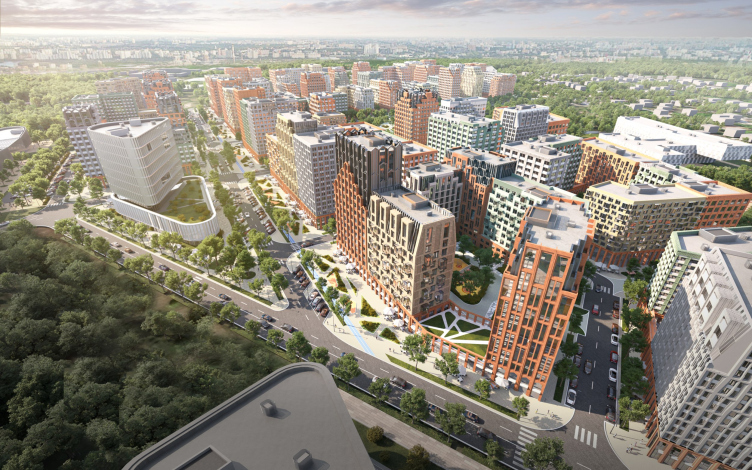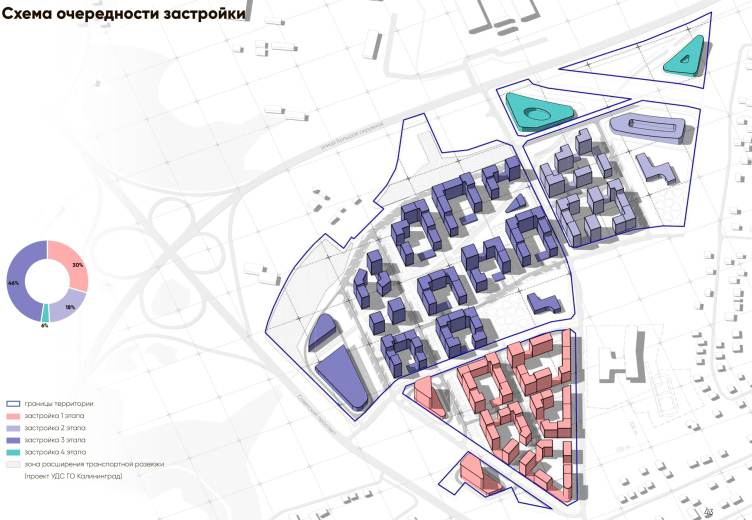However, the new area has one important advantage – it has a “genius loci” of its own: there is a brook running through it, which historically connected the forts, but now is in a dilapidated state. The architects are proposing to revive its lost meaning, turning it into the main “axis” and the main “event” of the landscaping project, as well as creating a basis for forming a historical route that would give the city people an opportunity to visit this remarkable place.
The residential area in Kaliningrad
Copyright: © ASADOV architects
The future residential area is situated in a “little corner” formed by the north fragment of the ring road and the Soviet Avenue – one of the main arteries of the city. In this location, the client was able to buy out six land sites of different shapes and sizes, whose total area amounted to over 30 hectares. Immediately beyond the ring road, the town of Chlalovsk begins – a settlement, which virtually became part of Kaliningrad – and the Chkalov military airbase. Its vicinity influenced the height of the complex. Other restrictions include the protected area of two nuclear power plants and a substation.
The residential area in Kaliningrad. The restrictions
Copyright: © ASADOV architects
The place could have been considered a usual city suburb with private residences, if it was not for one circumstance: the future complex is situated on the line of the so-called “Nocturnal Featherbed of Königsberg” – a row of fortification facilities of the XIX century that were built at 2-4 km intervals from one another for defending the city.
South of the district, there is Fort 5, aka “King Friedrich Wilhelm #5”, now hosting the Museum of the Great Patriotic War; north of the Koziy Forest, there is the derelict Fort #4 “Gneisenau”. The land site itself includes the auxiliary fortification I-Raum IVb – essentially a mound – and the Vozdushny brook that used to nourish the moats around the forts. Today, the brook is overgrown and is only filled with water depending on the precipitation.
The “population” of the future complex is considerable – almost 12,000 people. Designing the city blocks, the architects were searching for a balance between the economic performance requested by the client, a comfortable environment, and the self-sufficiency of the district. Since it is remote from the center of the city, conditions for different scenarios must be created here: people should not just sleep here but also work, walk, rest, make acquaintances, and develop new interests. The large public facilities must become points of attraction and draw inflows of people from other areas.
The residential area in Kaliningrad. The location plan
Copyright: © ASADOV architects
The residential/public buildings ratio is about 80/20. According to the company’s research, this figure is enough to provide the residents with workplaces, thus breaking away from the mono-polar model of the city. As for the residential construction, which steps back from the motorways and the site’s restrictions, the architects additionally protect it with a “belt” of public buildings. From the side of the Soviet Avenue and the Severny Obkhod, there will be large public and business buildings: office, shopping, cultural, and sports centers, as well as a multilevel car park. The micro-business may occupy the first floors of the buildings and be evenly spread across the entire district: the program of commercial premises is described in fine detail. Two kindergartners and a school are placed closer to the center of the district, where their territories merge, providing a smooth transition from the low-rise construction to the new regular and high-rise one.
The residential area in Kaliningrad. The functions
Copyright: © ASADOV architects
The residential area in Kaliningrad. A simplified master plan
Copyright: © ASADOV architects
The residential construction forms three clusters, separated by roads. Since all of them are designed in accordance with the same city block principle that forms a rather fine grid of the streets, this division is not clearly readable. The blocks consist of sections of different height, and the accents are by no means accidental: they have to do with viewing points, proximity to highways, or northern orientation. At least one underground level and the stylobate are occupied by car parks, on whose roof an elevated yard is situated. Thanks to the change of elevation and “pauses” up to the level of the first floor, the yards do not look “locked up” and cut off from the street.
One could say that working with every single block the Asadov architects in fact used the already-trivial “30/70” formula: each block offers high-profile, dominant, and background construction, which, among other things, is reflected in the apartment planning and works for mixing the social strata inside each block and the area on the whole. Instead of dividing the area into conventional “elite” and “middle class”, the architects combine them in a most natural way.
The residential area in Kaliningrad. The scale of a city block
Copyright: © ASADOV architects
The residential area in Kaliningrad. Scheme of typology of buildings and public spaces
Copyright: © ASADOV architects
The residential area in Kaliningrad. The scale of the city block. The general view
Copyright: © ASADOV architects
All these techniques are meant to create a dense and multifunctional environment that activates pedestrian flows and creates conditions for people interacting with one another and livening up the streets. The private and public spaces are divided, and the change of height and facade solutions forms a change of spatial impressions.
Making a recap, one can say that one of the main goals of the architects in this project was not just to arrange the space and fill it with meaning, but also to build connections: “unite and not divide”. The main thing that helps to solve this task is the fortification channel. Historically, it fenced off one territory from the other, but now the architects are aiming to reverse this function.
The brook crosses the site diagonally, introducing an element of “unpredictability” into the regular grid of the city blocks. Another thing that the architects turn into a diagonal is the “recreation axis” that stretches from the Soviet Avenue to the Severny Obkhod, connecting the public-and-business areas at the opposite ends of the district. One can extend this axis beyond these confines, connecting Forts 4 and 5 with a single historical route. Along the brook banks, a linear city park with a promenade is formed, with rest spaces, access to the water, and the neighboring center – it is situated next to the mound of I-Raum IVb. The pedestrian trails will be doubled with bicycle ones.
The residential area in Kaliningrad. An overview of the embankment
Copyright: © ASADOV architects
The residential area in Kaliningrad. An overview of the embankment
Copyright: © ASADOV architects
Yet another axis is formed where the underground power cables run, and it has a much more urban character. It pierces the city block from north to south – this is a classic pedestrian promenade with shops and cafes. In the space where the two axes cross, an eventful plaza appears.
The residential area in Kaliningrad. An overview of the pedestrian promenade
Copyright: © ASADOV architects
The residential area in Kaliningrad. The public spaces
Copyright: © ASADOV architects
In addition, each of the urban blocks has this or that advantage of its own: proximity to the brook, a public facility, school or boulevard – this adds diversity and individuality. Meanwhile, all the “public comforts” are within a walking distance from any part of the district. The complex is planned to be built in stages, starting with the “wedge” that is the closest to the city.
The Kaliningrad City Planning Council unanimously approved the concept.
The residential area in Kaliningrad. The construction stages
Copyright: © ASADOV architects




